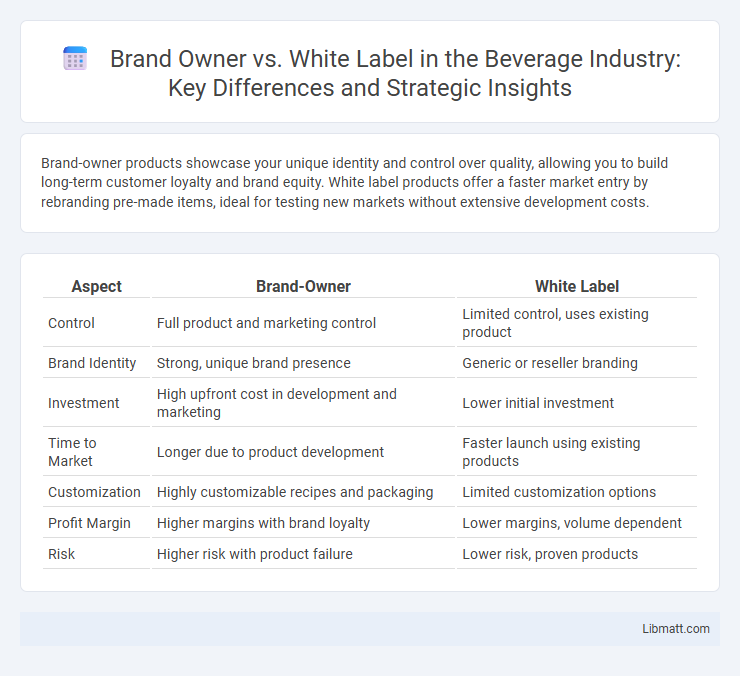Brand-owner products showcase your unique identity and control over quality, allowing you to build long-term customer loyalty and brand equity. White label products offer a faster market entry by rebranding pre-made items, ideal for testing new markets without extensive development costs.
Table of Comparison
| Aspect | Brand-Owner | White Label |
|---|---|---|
| Control | Full product and marketing control | Limited control, uses existing product |
| Brand Identity | Strong, unique brand presence | Generic or reseller branding |
| Investment | High upfront cost in development and marketing | Lower initial investment |
| Time to Market | Longer due to product development | Faster launch using existing products |
| Customization | Highly customizable recipes and packaging | Limited customization options |
| Profit Margin | Higher margins with brand loyalty | Lower margins, volume dependent |
| Risk | Higher risk with product failure | Lower risk, proven products |
Understanding Brand-Owned Products
Brand-owned products are developed, marketed, and sold under a company's own brand name, allowing full control over product quality, branding, and customer experience. Unlike white label products, which are manufactured by a third party and rebranded for resale, brand owners invest in product innovation and brand equity to build customer loyalty. Your commitment to brand ownership ensures unique market positioning and long-term business value.
What Is White Labeling?
White labeling allows companies to sell products manufactured by another company under their own brand name, enabling rapid market entry without investing in product development. You benefit from established production processes while maintaining control over marketing and customer experience. This contrasts with being a brand owner, who is responsible for product creation, quality control, and full brand management from inception.
Key Differences Between Brand-Owned and White Label
Brand-owned products are created, marketed, and sold under a company's unique identity, allowing full control over quality, design, and customer experience. White label products, on the other hand, are manufactured by third parties and rebranded for resale, enabling faster market entry without the need for product development. Choosing between brand-owned and white label depends on your business goals, investment capacity, and desire for control over branding and product differentiation.
Pros and Cons of Brand Ownership
Brand ownership offers significant control over product quality, marketing strategies, and brand identity, allowing you to build long-term customer loyalty and differentiate your offerings in competitive markets. However, it requires substantial investment in product development, branding, and inventory management, which can increase financial risk and operational complexity. Owning a brand also demands ongoing innovation and marketing efforts to maintain relevance, unlike white labeling where these responsibilities are largely handled by the supplier.
Pros and Cons of White Label Products
White label products offer cost-effective and rapid market entry by allowing businesses to rebrand pre-made goods without the need for product development, reducing time and investment. However, white label items often lack customization options and unique brand identity, potentially leading to lower customer loyalty and increased competition from similar generic products. Dependence on the white label manufacturer for quality control and supply chain reliability can pose risks, impacting brand reputation if issues arise.
Cost Comparison: Brand Owner vs White Label
Brand owners face higher upfront costs due to expenses in product development, branding, and marketing efforts compared to white label solutions where products are pre-made and only rebranded. White label options significantly reduce investment by eliminating production and R&D costs, allowing faster market entry with lower financial risk. However, brand owners may achieve higher margins long-term through unique product differentiation despite greater initial expenditures.
Branding and Customization Flexibility
Brand owners maintain full control over branding and customization, allowing unique product designs, packaging, and brand voice that align closely with their business identity. White label products offer limited customization, often restricting changes to logos or minor labeling adjustments, making it harder to differentiate your offerings in competitive markets. Choosing brand ownership enables greater flexibility to tailor products and branding strategies, enhancing customer loyalty and market positioning.
Quality Control and Product Consistency
Brand-owners maintain strict quality control protocols and direct oversight over manufacturing processes, ensuring consistent product standards and adherence to their brand specifications. White label products often rely on third-party manufacturers, which can lead to variability in quality and product consistency due to less direct control and differing production standards. Establishing rigorous supplier evaluation and ongoing monitoring is critical for white label products to achieve reliable quality comparable to established brand-owner offerings.
Market Positioning and Consumer Perception
Brand-owners establish unique market positioning by creating distinctive product identities that build strong consumer loyalty and trust. White label products rely on established market demand, often perceived as cost-effective alternatives with less brand differentiation. Your choice between these models directly affects how consumers perceive authenticity, quality, and value in the marketplace.
Choosing the Right Model for Your Business
Choosing the right model for your business depends on factors like control, branding, and investment capacity. Brand-owner models offer full control over product development and marketing, enhancing brand identity, while white label products provide quicker market entry with lower costs by reselling pre-made items under your branding. Evaluate your long-term goals and resource availability to determine whether building your own brand or leveraging existing products best aligns with your business strategy.
Brand-owner vs white label Infographic

 libmatt.com
libmatt.com